The Intel Core i9-13900KS Review: Taking Intel's Raptor Lake to 6 GHz
by Gavin Bonshor on January 27, 2023 10:00 AM ESTCPU Benchmark Performance: Power And Office
Our previous sets of ‘office’ benchmarks have often been a mix of science and synthetics, so this time we wanted to keep our office section purely on real-world performance. We've also incorporated our power testing into this section too.
The biggest update to our Office-focused tests for 2023 and beyond include UL's Procyon software, which is the successor to PCMark. Procyon benchmarks office performance using Microsoft Office applications, as well as Adobe's Photoshop/Lightroom photo editing software, and Adobe Premier Pro's video editing capabilities. Due to issues with UL Procyon and the video editing test, we haven't been able to properly run these, but once we identify a fix with UL, we will re-test each chip.
We are using DDR5 memory on the 12th and 13th Gen Core parts, as well as the Ryzen 7000 series, at the following settings:
- DDR5-5600B CL46 - Intel 13th Gen
- DDR5-5200 CL44 - Ryzen 7000
- DDR5-4800 (B) CL40 - Intel 12th Gen
All other CPUs such as Ryzen 5000 and 3000 were tested at the relevant JEDEC settings as per the processor's individual memory support with DDR4.
Clockspeeds
Taking a quick look at clockspeeds, we know that the i9-13900KS can hit 6.0GHz on just two of its CPU cores – the so called "favored cores" under Turbo Boost Max 3.0 (TBM3). This is a combination of TBM3 allowing these best cores to get to 5.8GHz, and then TVB taking them to 6.0GHz when there's suitable thermal headroom.
Once you exceed 2 threads (or rather, needing to occupy 2 CPU cores), however, then i9-13900KS has to back off on its clockspeeds, even under the most opportunistic scenarios. In this case the highest clockspeed available, regardless of which cores are in use, is 5.6GHz, the set limit for Intel's Adaptive Boost Technology (ABT). Long and short, this means that in workloads with more than a couple of threads (e.g. encoding and most games), the highest the chip is going to be able to clock is 5.6GHz.

*both P-Core 4 and 5 are designated for Turbo Boost Max 3.0 and Thermal Velocity Boost (TVB)
Overall from our 5-minute test looping CineBench's Multi-Threaded test, the above table illustrates each P-Core maximum frequency, along with the average frequency for the run duration. The designated cores for Intel's TBM3 on this particular Core i9-13900KS sample were P-Core 4 and P-Core 5. Both of these cores hit 6 GHz as advertised, but due to TBM3 limitations in this MT test, they didn't remain at 6 GHz for long, as we can see. The average frequency is the important one, as this is the typical core clock speed on each of the P-Cores for our 5-minute blast.
Power
The nature of reporting processor power consumption has become, in part, a bit of a nightmare. Historically the peak power consumption of a processor, as purchased, is given by its Thermal Design Power (TDP, or PL1). For many markets, such as embedded processors, that value of TDP still signifies the peak power consumption. For the processors we test at AnandTech, either desktop, notebook, or enterprise, this is not always the case.
Modern high-performance processors implement a feature called Turbo. This allows, usually for a limited time, a processor to go beyond its rated frequency. Exactly how far the processor goes depends on a few factors, such as the Turbo Power Limit (PL2), whether the peak frequency is hard coded, the thermals, and the power delivery. Turbo can sometimes be very aggressive, allowing power values 2.5x above the rated TDP. And in the case of high-performance processors on high-end motherboards, all of these values are arguably theoretical anyhow, as motherboard vendors will commonly throw the limits out the window and let chips draw all the power they want in order to wring out every last bit of performance.
AMD and Intel have different definitions for TDP that are, broadly speaking, applied the same. The difference comes from turbo modes, turbo limits, turbo budgets, and how the processors manage that power balance. These topics are 10000-12000 word articles in their own right, and we’ve got a few articles worth reading on the topic.
- Why Intel Processors Draw More Power Than Expected: TDP and Turbo Explained
- Talking TDP, Turbo and Overclocking: An Interview with Intel Fellow Guy Therien
- Reaching for Turbo: Aligning Perception with AMD’s Frequency Metrics
- Intel’s TDP Shenanigans Hurts Everyone
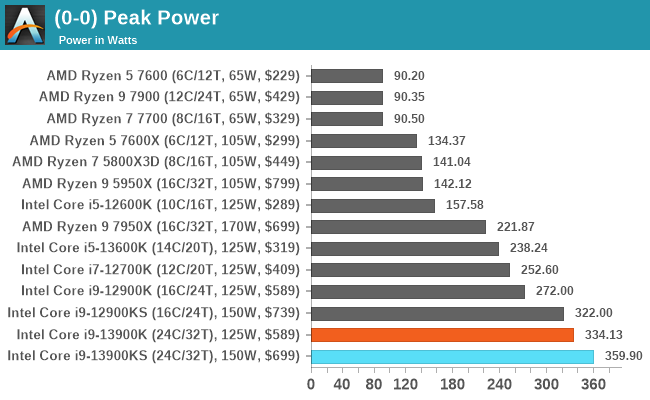
The peak power figures from our power testing show that the Core i9-13900K drew an impressive 359.9 W at full load. This puts it around 26 W higher than our testing in our review of the Core i9-13900K, which given the bumps to the P-core and E-core base frequencies, along with the 6 GHz turbo clock speed on the P-cores, isn't that bad.
Of course, a processor pulling 360 W in an age where home energy prices are at record highs globally isn't very favorable for various reasons. There's not much efficiency from the Intel 7 process at these levels, especially when directly compared to the 5 nm AMD Zen 4 core. The other caveat is 360 W isn't that easy to cool in a conventional desktop case with a typical tower air cooler, and users looking to use the Core i9-13900KS (and 13900K) need to invest in a suitable premium AIO cooler or custom water cooling for optimal performance.
Moving deeper into our Core i9-13900KS Prime 95 sustained power test, we can see that the chip is consistently hitting between 330 W and 340 W for a prolonged period. At the beginning of the workload being placed on the cores, it hits 359.9 W very quickly through the 6 GHz cores amid the extra power requirements this needs to work optimally.
While we saw a much more sporadic sustained power draw on the Core i9-13900K, the Core i9-13900KS draws more power for a longer period. The 6 GHz P-core turbo quickly started to drop off, and within half a minute, the power was down from 360 W to around 340 W before settling somewhat.
Office/Web
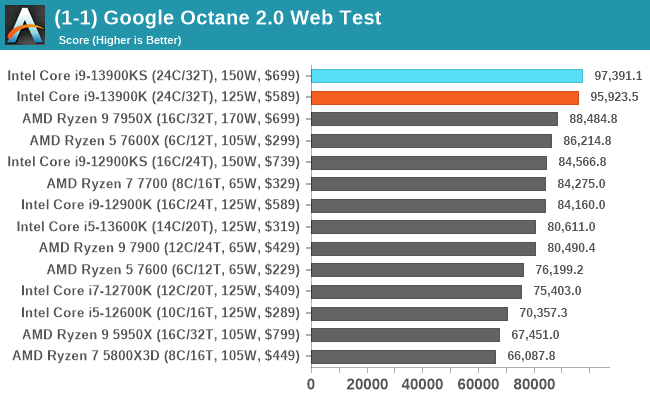
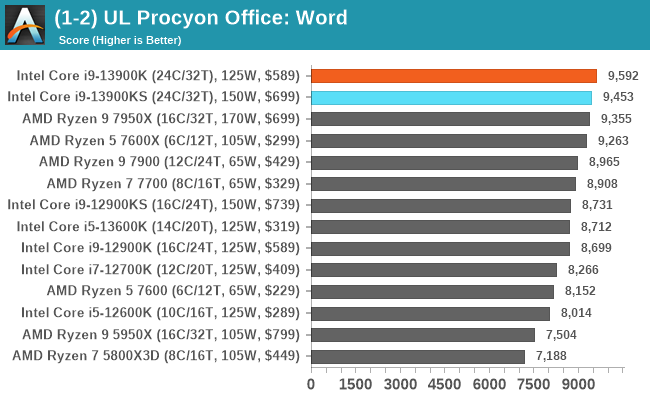
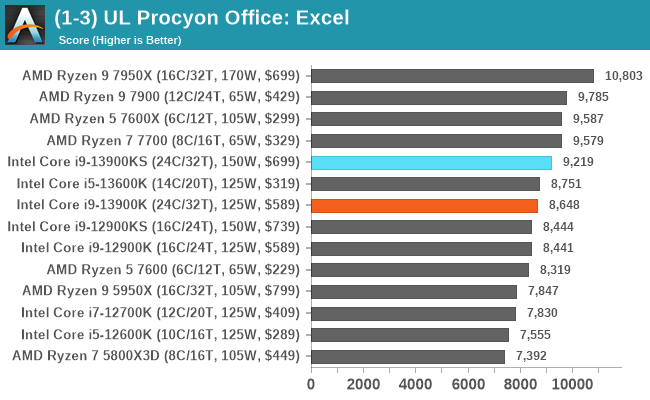
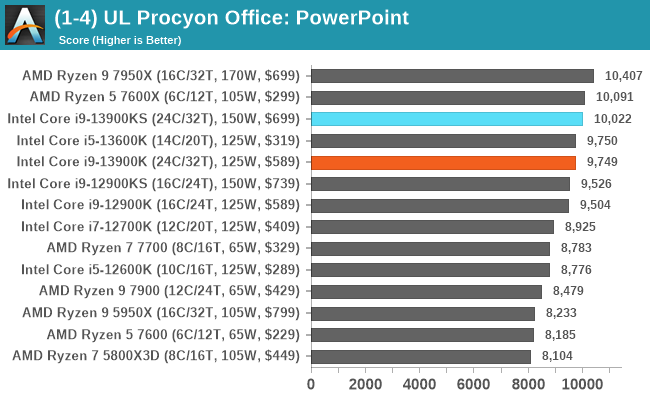
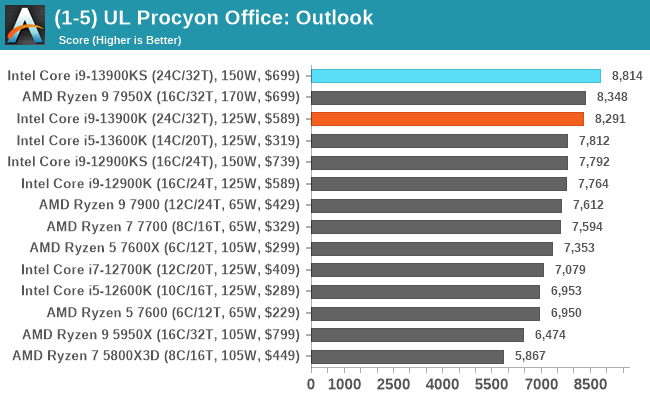
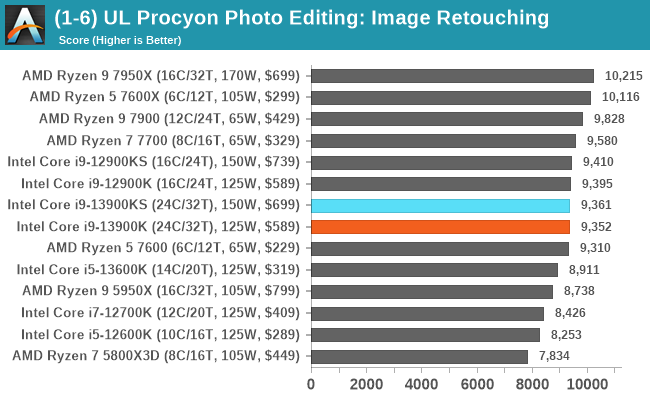
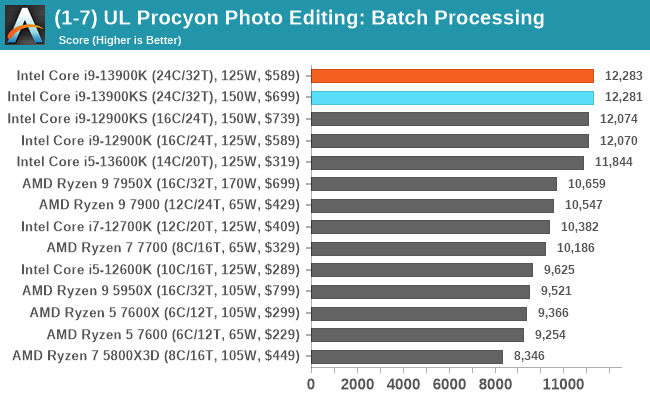
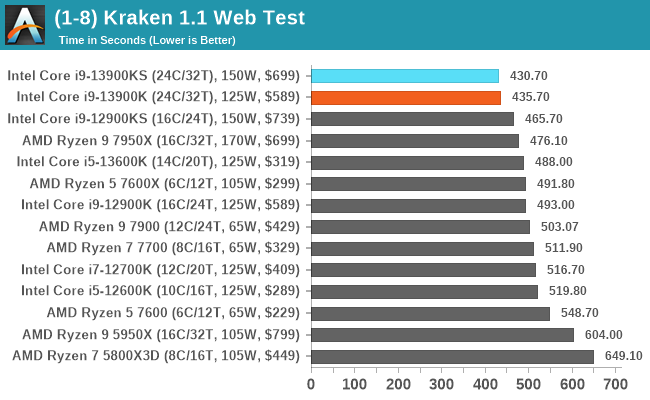
In our office and web-based benchmarks, the Core i9-13900KS, for the most part, was marginally better than the Core i9-13900K. This is expected, although we saw a significant performance jump in UL's Procyon Microsoft Office Outlook test.


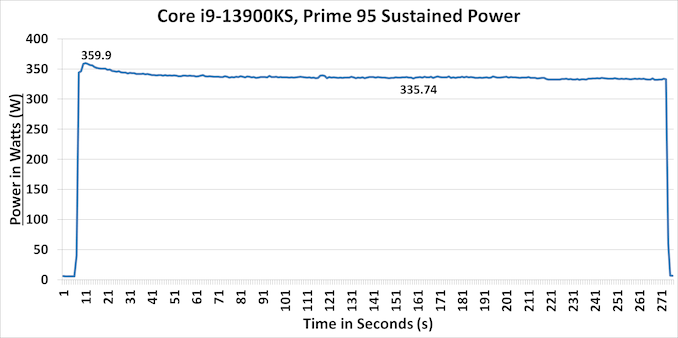








39 Comments
View All Comments
Gavin Bonshor - Friday, January 27, 2023 - link
It is doing weird and crazy things with all my chips. On half of them, it will even refuse to POST. I've reached out to MSI UK, but I'm yet to receive a response. At this point, I may as well re-test all the 13th Gen SKUs on another board for parity purposes.PeachNCream - Friday, January 27, 2023 - link
I could think of better things to do with 360W of power like running ALL of the lights in my home, running my laptop at full load, charging and using my phone, and feeding the router necessary to support my internet connection (and I would still have close to 100W left for other things). With a 13900KS, you get a CPU and nothing else, not even cooling for said processor let alone the rest of the computer hardware in the system required to support it. Enthusiasts are apparently idiots with bottomless lines of credit that Intel thinks will brainlessly pay interest to VISA and, sadly, they might be right.jgrimm2364 - Thursday, February 2, 2023 - link
I paid cash for mine and love it. Cheaper than the i74930k I built 8 or 9 years ago. When a processor kicks most others butts for that long, it's worth paying for. It's like buying a performance car vs a grocery getter. It performs!PeachNCream - Sunday, February 5, 2023 - link
Car people "logic" also escapes me because of how self-centered it is to expend more of our limited energy resources than necessary to accomplish something, but huge pickup trucks, gigantic SUVs, and pointlessly overpowered cars are around in large numbers so at least you can safely say you followed the school of fish into the proverbial mouth of a demise of your own making as you suffer while living on a trashed planet. GG Earthdontlistentome - Friday, January 27, 2023 - link
320w. Just disgusting waste.This is the most retarded CPU since the dying days of the Pentium 4.
blppt - Saturday, January 28, 2023 - link
I think you have blotted the 9590 out of your memory.Jorgp2 - Saturday, January 28, 2023 - link
Or the 7950x which still uses 260wemike09 - Friday, January 27, 2023 - link
Please add Microsoft Flight Simulator to your benchmark tests. Few games are so demanding on the CPU as MSFS. When you look at the posted gaming benchmarks, there's little difference between most CPUs for each game benchmarked. Throw in a game that really showcases what a CPU can do in a CPU demanding title.ballsystemlord - Friday, January 27, 2023 - link
Is MFS really CPU intensive? Or does it just use one thread much like Quake III? If that's the case then you can just benchmark ioquake or OpenArena.Or for an even more hilarious result, why not try a multi-threaded python program? Then you could watch that CPU intensive GIL (Global Interpreter Lock) wreak havoc on the tested CPUs via python's polling process.
ballsystemlord - Friday, January 27, 2023 - link
PS: You'd have to request a high frame rate, like 500fps, for a Quake III client to saturate the CPU.